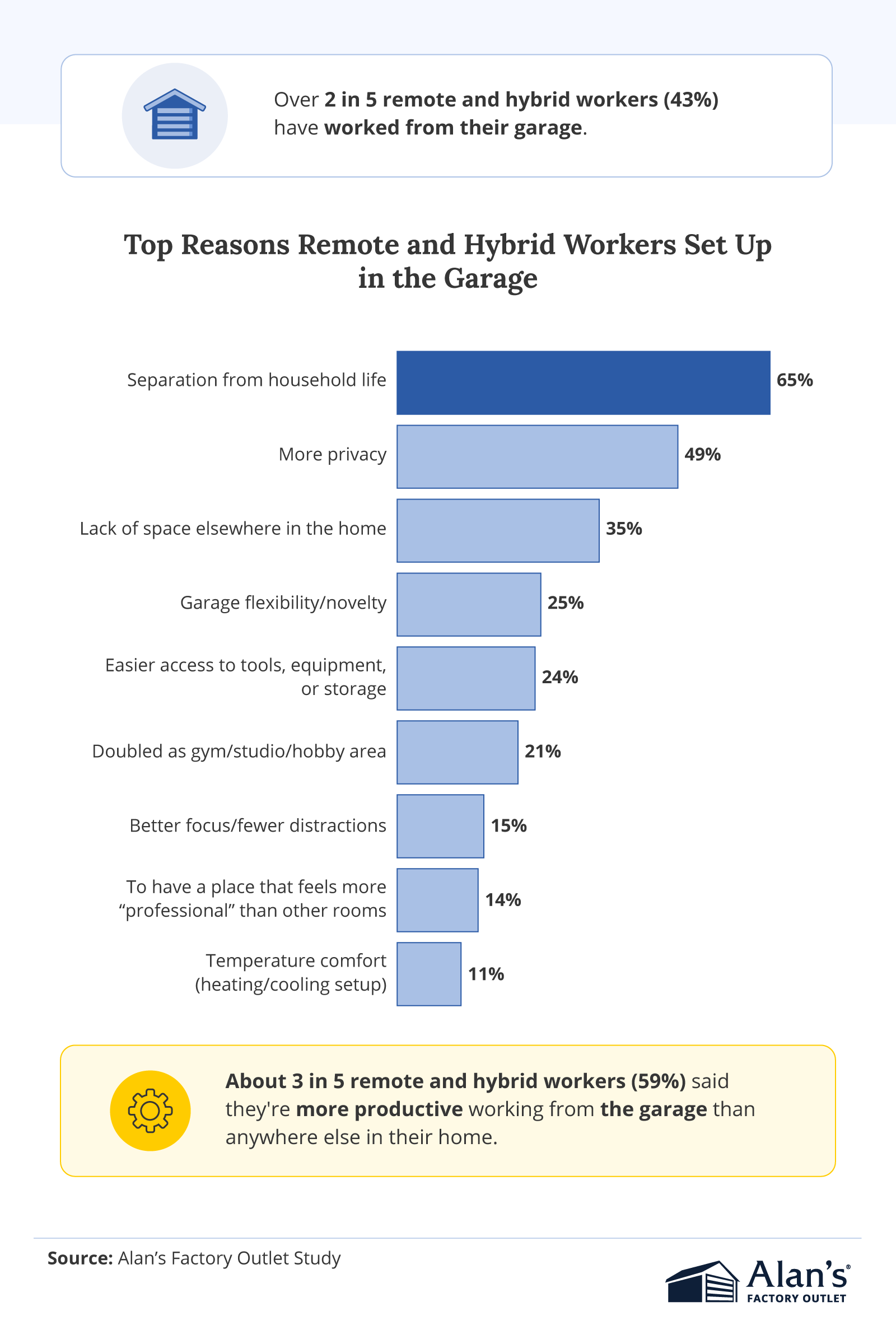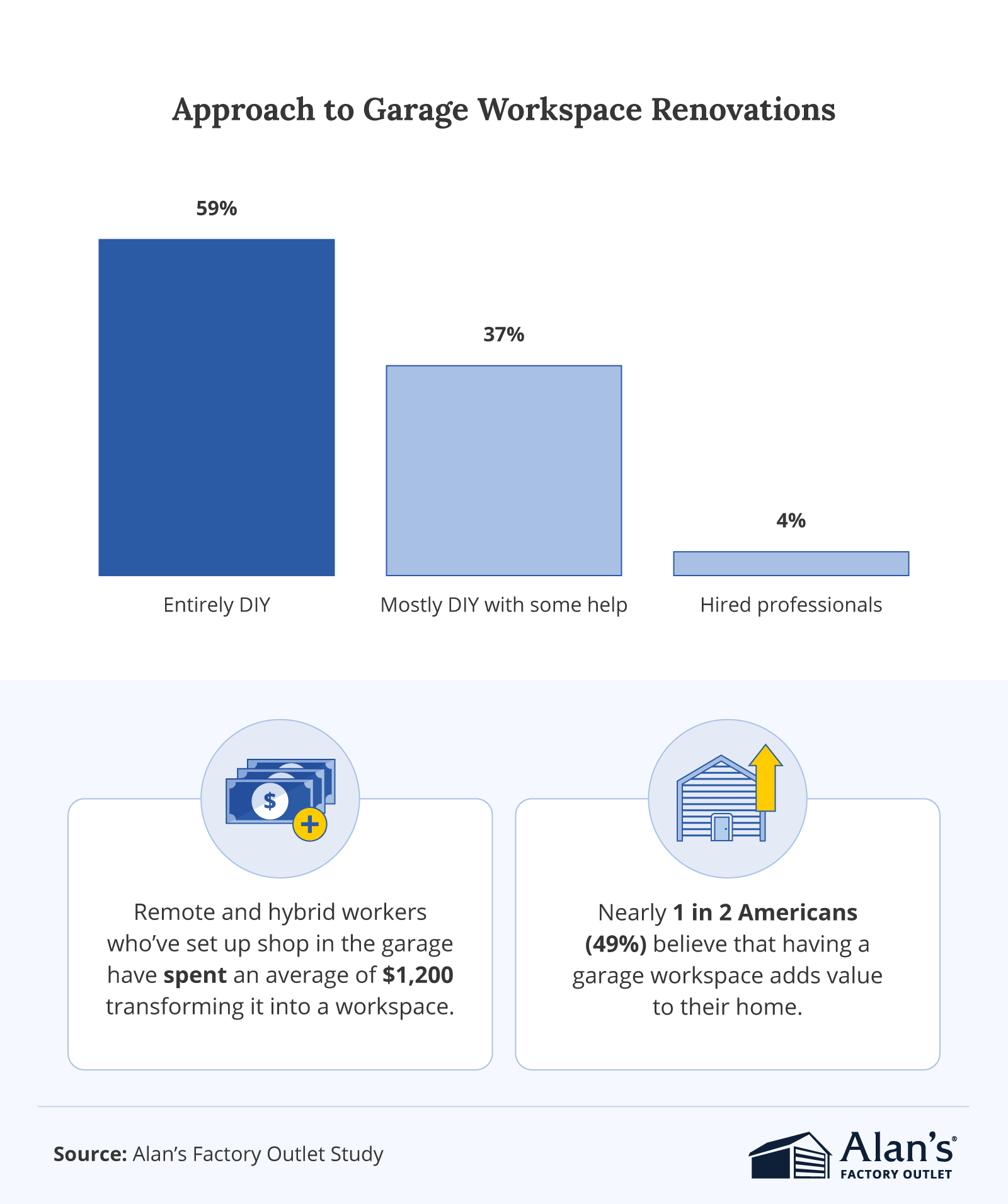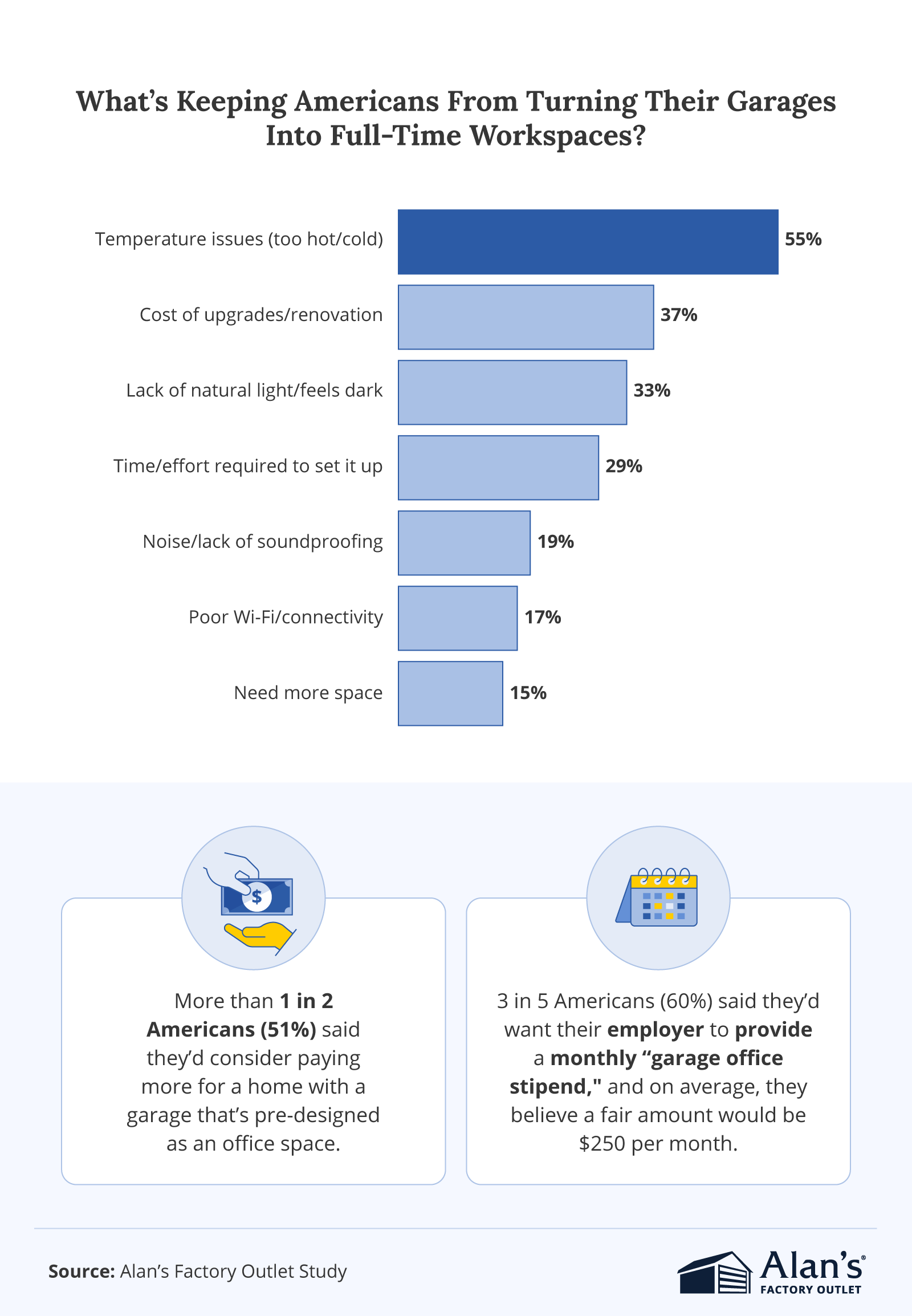Alan’s Factory Outlet surveyed 1,000 U.S. remote and hybrid workers to uncover how people are repurposing garages into modern workspaces. This report explores how often workers use their garages as offices, what upgrades they’ve made, and how productivity compares to other spaces in the home. With more Americans turning temporary work-from-home setups into permanent solutions, the garage has quietly emerged as one of the most versatile rooms of the house.
Key Takeaways
- Over 2 in 5 remote and hybrid workers (43%) have worked from their garage.
- About 3 in 5 remote or hybrid workers (59%) say they’re more productive working from the garage than anywhere else in their home.
- Nearly 1 in 2 Americans (49%) believe that having a garage workspace adds value to their home.
- More than 1 in 2 Americans (51%) say they’d consider paying more for a home with a garage that’s pre-designed as an office space.
- 3 in 5 Americans (60%) say they’d want their employer to provide a monthly “garage office stipend,” and on average, they believe a fair amount would be $250 per month.
Garages as Productivity and Career Boosters
From boosting focus to advancing careers, garages have become a surprising work-from-home solution.

Over 2 in 5 remote and hybrid workers (43%) reported working from their garage, and 59% said the space made them more productive than other areas of their homes. The top industries embracing the garage office included:
- Construction/Trades
- Transportation/Logistics
- Technology
- Retail
- Hospitality
For hybrid workers, 48% have tried the garage setup, and 9% use it every workday. Among fully remote professionals, 38% have worked in their garage, including 17% who use it as their daily office. Nearly 2 in 5 six-figure earners (39%) have worked from their garage, showing that even high-income professionals find value in this space.
Workers cited several reasons for setting up shop in the garage, including:
- Physical separation from household life (65%)
- More privacy (49%)
- Lack of space elsewhere in the home (35%)
- Garage flexibility or novelty (25%)
- Easier access to tools, equipment, or storage (24%)
- Doubles as a gym, studio, or hobby area (21%)
- Better focus and fewer distractions (15%)
- A place that feels more professional than other rooms (14%)
- Temperature comfort with heating or cooling setups (11%)
Another 77% of workers said their garage office provided the mental separation they needed between home and work life. These factors show why many workers see the garage as a flexible space that supports both focus and creativity.
The benefits of working in a garage also extended to career outcomes. Thanks to the productivity boost of being in this space, 23% of remote and hybrid workers said that it led to more recognition at work. Another 23% said their garage office setup helped them earn a raise, while 17% credited it with getting a promotion.
Renovating the Garage Into a Workplace
Creating a garage office often involves intentional upgrades and investments.

Nearly half of Americans (49%) believed that having a garage workspace added value to their home. On average, remote and hybrid workers spent $1,200 to convert a garage into a home office. A majority approached the project on their own, with 59% doing everything as a DIY effort, 37% handling most tasks with some help, and only 4% hiring professionals.
Many workers focused on functional upgrades to improve their garages, such as:
- Desk and seating setups (53%)
- Storage and organization improvements (40%)
- Lighting upgrades (40%)
- Added electrical outlets or extension cords (31%)
- Wi-Fi extender or router upgrades (30%)
- Flooring (29%)
- Heating or cooling systems (28%)
- Mini fridges (26%)
- Painted walls and decor (25%)
- Plants or greenery (18%)
Some workers made even larger investments. Over 1 in 10 (11%) spent more than $3,000, while 13% said they plan to turn their garage into a full-time or permanent office. Spending appeared to pay off: 75% of those who invested more than $1,000 reported being much more productive, compared to 63% of those who spent less.
Financial opportunity was also on workers’ minds. More than 1 in 4 Americans (28%) said they would consider renting out their garage office, asking about $450 per month on average. Interest was especially strong among younger workers. More than 1 in 3 Gen Z (35%) and 31% of millennials said they’d be willing to rent out their space.
The Future of Garage Offices
Many workers envision the garage as more than just an improvised solution. It’s quickly becoming a desired home feature.

More than half of Americans (51%) said they would pay more for a house with a garage pre-designed as an office. Younger generations in particular expressed strong interest, as 55% of Gen Z and 50% of millennials would pay more for a home with a built-in garage office. When it came to upgrading their own garages into offices, workers ranked these features as the most desirable:
- Heating and cooling (50%)
- Natural light or windows (42%)
- Insulation (35%)
- Flooring (34%)
- Electrical outlets or better power access (33%)
- Painted walls or decor (31%)
- Soundproofing (30%)
- Storage and organization (28%)
- Better backgrounds for video calls (28%)
- Wi-Fi extenders (27%)
- Plants or greenery (20%)
- Coffee station or mini fridge (19%)
Overall, 60% of remote and hybrid workers said they would love it if their employer provided a monthly garage office stipend to help them improve their work-from-home space. On average, they agreed that a fair amount would be $250 per month. Millennials (63%) and Gen Z workers (62%) were the most likely to want this perk.
The Garage’s New Role in Work-Life Balance
The garage has evolved from a storage space into a practical and productive workspace for many remote and hybrid employees in the U.S. With investments in upgrades and growing recognition of its value, the garage office trend highlights the adaptability of American households. As more people look for permanent solutions to work-from-home challenges, the garage may continue to rise as one of the most important rooms in the house.
Methodology
We surveyed 1,000 American remote and hybrid workers to learn about their use of garages as workspaces. The average age of respondents was 40. The generational breakdown of respondents was as follows: Gen Z (13%), millennials (50%), Gen X (32%), and baby boomers (4%). Due to rounding, some percentages in this study may not total 100% exactly.
About Alan’s Factory Outlet
Alan’s Factory Outlet provides durable and affordable metal buildings, garages, and carports to meet a variety of needs. With customization options to fit different lifestyles, Alan’s Factory Outlet helps homeowners make the most of their property, whether that means adding extra storage, shelter, or even creating new spaces like a garage office.
Fair Use Statement
The survey findings in this report can be shared for noncommercial purposes only. Please provide proper attribution and a link back to Alan’s Factory Outlet when referencing this content.

